
Myrmicinae is a subfamily of ants, with about 140 extant genera; their distribution is cosmopolitan. The pupae lack cocoons. Some species retain a functional sting. The petioles of Myrmicinae consist of two nodes. The nests are permanent and in soil, rotting wood, under stones, or in trees.

Dorylus, also known as driver ants, safari ants, or siafu, is a large genus of army ants found primarily in central and east Africa, although the range also extends to southern Africa and tropical Asia. The term siafu is a loanword from Swahili, and is one of numerous similar words from regional Bantu languages used by indigenous peoples to describe various species of these ants. Unlike the New World members of the former subfamily Ecitoninae, members of this genus form temporary subterranean bivouacs in underground cavities which they excavate and inhabit - either for a few days or up to three months. Also unlike some New World army ants, driver ants are not specialized predators of other species of ant, instead being more generalistic with a diet consisting of a diversity of arthropods. Colonies are enormous compared to other army ants and can contain over 20 million individuals. As with their American counterparts, workers exhibit caste polymorphism with the soldiers having particularly large heads that power their scissor-like mandibles. They are capable of stinging, but very rarely do so, relying instead on their powerful shearing jaws. Driver ant queens are the largest living ants known, with the largest measuring between 40 - 63 millimeters in total body length depending on their physiological condition.
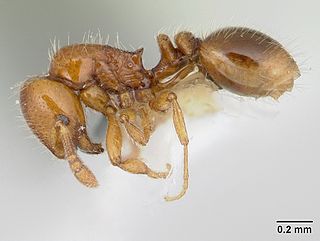
Oxyepoecus is a Neotropical genus of ant in the subfamily Myrmicinae. The genus is a member of the tribe Solenopsidini and currently includes 20 species.

Pseudomyrmex is a genus of stinging, wasp-like ants in the subfamily Pseudomyrmecinae. They are large-eyed, slender ants, found mainly in tropical and subtropical regions of the New World.
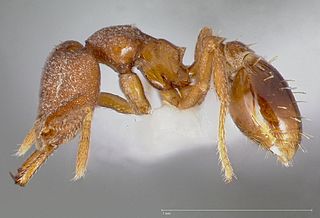
Strumigenys is a genus of ants in the subfamily Myrmicinae.

Tetraponera is a genus of ants in the subfamily Pseudomyrmecinae that are commonly known as slender ants and are characterized by their arboreal nature and slender bodies. The 96 described species of Tetraponera all of which live in hollow structures of plants and trees, such as thorns or branches; these hosts are known as myrmecophytes. Tetraponera species are closely related to the New World genus of ants Pseudomyrmex, but differ in their relationships with host plants.

Myrmecina is a genus of ants in the subfamily Myrmicinae. It contains 53 species distributed in North America, Europe, northern Africa, India east, Korea, Japan and Australia.

Myopias is a genus of ants in the subfamily Ponerinae. The genus is known from the Oriental, Indo-Australian, and Australasian regions.

Ecsenius mandibularis, also known as the many-toothed blenny, Queensland combtooth blenny or Queensland blenny in Australia, is a species of combtooth blenny in the genus Ecsenius. It is found in coral reefs in the western Pacific ocean, including the southern edge of the Great Barrier Reef. It can reach a maximum length of 7.5 centimetres. Blennies in this species feed primarily off of plants, including benthic algae and weeds.

Plectroctena is an Afrotropical genus of ants, with most species occurring in the rainforest zones of West and Central Africa. Some species are cryptic or subterranean foragers, while others forage in open grassland terrain. The workers forage singly or in groups of 2 to 3. They nest in the earth at varying depths, or in collapsed logs. They prey mainly on millipedes, including their young or eggs.

Thaumatomyrmex is a Neotropical genus of ants in the subfamily Ponerinae, found from Mexico to Brazil. They are notable for their pitchfork-shaped mandibles, which they use to capture millipedes of the order Polyxenida. The genus is a specialist predator of polyxenids, and one of only two ant genera known to prey upon polyxenids.

Trachymyrmex is a genus of fungus-growing ants in the subfamily Myrmicinae. The genus is mainly tropical in distribution, with most species being found in Central and South America.
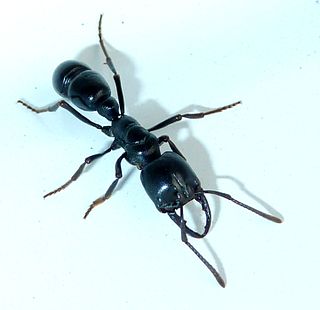
Plectroctena mandibularis is a large species of ant that ranges from the Eastern Cape, South Africa, through East Africa to Ethiopia. Their workers forage singly in open terrain, and their colony size seldom exceeds 50 individuals. It is one of the large Plectroctena species, including P. conjugata and P. minor, that specialize on adult millipedes as prey. The nest is composed of chambers that are typically located 2 feet or more below the surface, and the nest entrances are usually marked by large piles of earth.

Technomyrmex is a genus of ants in the subfamily Dolichoderinae. With 98 species, it is one of the largest and most diverse ant genera in the Dolichoderinae. The genus distributed throughout the tropical and subtropical zones with most species occurring in the Oriental-Malesian and Afrotropical regions. One species, Technomyrmex albipes is a tramp ant now widespread throughout the tropics due to human activities.

Neivamyrmex is a genus of army ants in the subfamily Dorylinae.
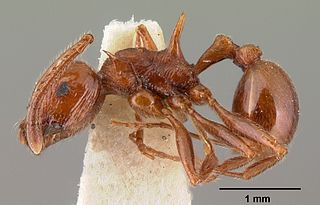
Pristomyrmex is a genus of ants in the subfamily Myrmicinae.

Lenomyrmex is a Neotropical genus of ant in the subfamily Myrmicinae.
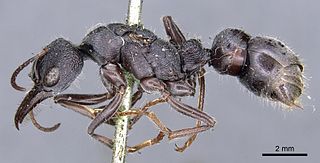
Myrmecia rugosa is an Australian ant which belongs to the genus Myrmecia. This species is native to Australia. Their distribution in Australia is nationwide but are not common in the northern regions of Australia.

Baikuris is an extinct genus of ant in the Formicidae subfamily Sphecomyrminae, and is currently placed in the tribe Sphecomyrmini. The genus contains four described species: the type species Baikuris mandibularis, along with Baikuris casei, Baikuris maximus, and Baikuris mirabilis.

Strumigenys ayersthey is a species of ant found in Chocó region of Ecuador. It is the only species belonging to the group of Strumigenys that has a long jaw, bigger jaw structure and lacks stretches in its cuticule.




















